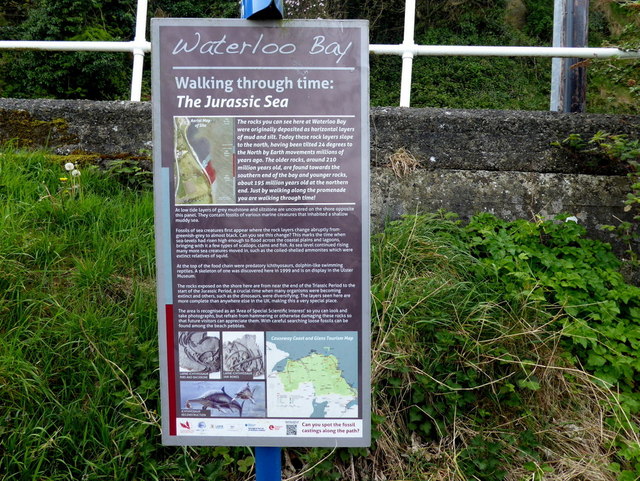Waterloo Bay notice, Larne
Introduction
The photograph on this page of Waterloo Bay notice, Larne by Kenneth Allen as part of the Geograph project.
The Geograph project started in 2005 with the aim of publishing, organising and preserving representative images for every square kilometre of Great Britain, Ireland and the Isle of Man.
There are currently over 7.5m images from over 14,400 individuals and you can help contribute to the project by visiting https://www.geograph.org.uk

Image: © Kenneth Allen Taken: 23 Apr 2019
The following text is included in the description: The rocks you can see here at Waterloo Bay were originally deposited as horizontal layers of mud and silt. Today these rock layers slope to the north, having been tilted 24 degrees to the North by Earth movements millions of years ago. The older rocks, around 210 million years old, are found towards the southern end of the bay and younger rocks, about 195 million years old at the northern end. Just by walking along the promenade you are walking through time! At low tide layers of grey mudstone and siltstone are uncovered on the shore opposite this panel. They contain fossils of various marine creatures that inhabited a shallow muddy sea. Fossils of sea creatures first appear where the rock layers change abruptly from-greenish-grey to almost black. Can you see this change? This marks the time when sea-levels had risen high enough to flood across the coastal plains and lagoons, bringing with it a few types of scallops, clams and fish. As sea level continued rising many more sea creatures moved in, such as the coiled-she lied ammonites which were extinct relatives of squid. At the top of the food chain were predatory ichthyosaurs. dolphin-like swimming reptiles. A skeleton of one was discovered here in 1999 and is on display in the Ulster Museum. The rocks exposed on the shore here are from near the end of the Triassic Period to the start of the Jurassic Period, a crucial time when many organisms were becoming extinct and others, such as the dinosaurs, were diversifying. The layers seen here are more complete than anywhere else in the UK, making this a very special place. The area is recognised as an 'Area of Special Scientific Interest' so you can look and take photographs, but refrain from hammering or otherwise damaging these rocks so that future visitors can appreciate them. With careful searching loose fossils can be found among the beach pebbles. Pictured here Image]

